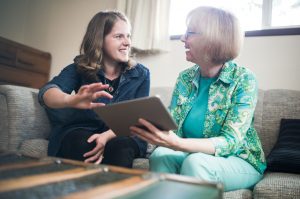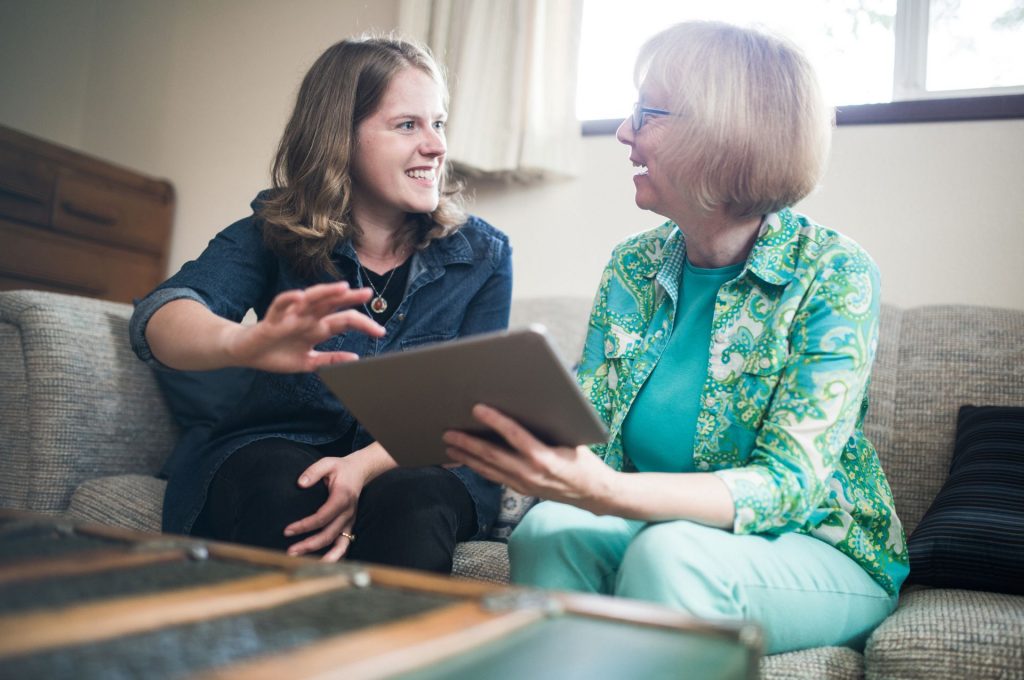Partnerships
Take advantage of different types of partnerships for different stages of the reuse process. There is partnership potential at national, regional, and local levels. For example, at a national level you can partner with national charities running end-to-end schemes. Local level partnerships can include local authorities, libraries and schools, local charities, the NHS and local groups such as sporting societies. Often, partnerships begin serendipitously, or develop from pre-existing relationships, but can also be fostered through more formal processes.
“Partnering with Good Things Foundation’s National Device Bank ensures that your organisation can benefit from a national end-to-end service, with industry accredited security processes. It’s a cost-neutral alternative IT asset disposal – with benefits for people, and the planet.”
Helen Milner OBE, CEO of Good Things Foundation
Potential partners for the refurbishment process
- Offset risk by working with commercial partners who can take responsibility for assessment, data wiping, refurbishment and repair of devices.
- Costings easier as commercial partners already have financial systems in place.
- Commercial partners are usually able to take in large amounts of devices and a range of different devices that might be more difficult to deal with in-house.
- Commercial partners should have the ability to recycle or dispose of devices identified as e-waste in the proper way.
- Partner with a local accredited e-waste recycling organisation if you have one, to ensure that any unsuitable devices are recycled/disposed of in a responsible, cost-effective and environmentally-friendly way that also ensures legal compliance.
- Ensure that partners are able to provide you with adequate reporting around outcomes for your devices.
Standards to look for:
The following list is not exhaustive, but these are standards to look for in potential partners that reflect robust processes which are followed and regularly checked:
- ISO9001 indicates that an organisation has policies and procedures in place to assure quality, that these are followed and are regularly updated
- ISO14001 indicates that an organisation adheres to environmental standards
- ISO45001 indicates that an organisation adheres to Health and Safety standards
- ISO27001 indicates that an organisation adheres to data security standards
- NIST standards: 800-88 Standard for Media Sanitisation
- Waste carrier certifications
- IEEE 2883-2022 – Standard for sanitising storage
Potential partners for distribution process
- Partners must be able to meet your needs.
- How will they meet any distribution criteria you have identified?
- How will they report on impact?
- Who will be responsible for secure storage of devices?
- Multiple partners could help spread impact across different beneficiary groups.
- You could find a partner that will manage the entire process end-to-end for you. For example, Good Things Foundation runs a large-scale national scheme for adults through The National Device Bank
. Sustainability charity Hubbub
in partnership with Virgin Media O2, accepts smartphones from consumers and businesses across the UK and Digital Poverty Alliance
runs device donation projects nationally and bespoke schemes and pilots in local areas. You might also be able to find a locally based electronics refurbisher that is able to redistribute devices back into the community for a truly local circular economy approach. Recycle your Electricals have a directory on their website that shows where to repair, donate, sell and recycle electronic devices. Visit Recycle Your Electricals
to find your nearest drop off point.
- Some local authorities and combined authorities have regional or local schemes in place. See, for example, research on A Regional Approach to IT Reuse for Good: Opportunities in the West Midlands.
- Organisations like schools and libraries might be able to work with you to
- act as hubs with links to local groups and ways to reach your local community.
- act as distribution points.
- raise awareness of your programme.
- set up device lending libraries.
Make sure you are clear on your offer if working with schools, as they will have strict safeguarding responsibilities. Similarly, make sure you are clear what services libraries are willing/able to contribute, as many have had to reduce their offer over recent years.
- Third sector organisations like charities might be able to support you through
- providing detailed knowledge of their local area and its needs.
- spreading the word about device distribution in the community they serve.
- providing access to a particular target population such as older people or people with disabilities.
- taking devices to use in their offices and/or distribute to their volunteers.
- providing wraparound digital skills sessions/support
- Local hospitals and other NHS bodies
- might already have digital inclusion schemes in place.
- will know which of their patients struggle to access the internet and are in need of help.
- Local universities might be able to help with work
- identifying digital inclusion and sustainability needs in your area.
- evaluating impact and outcomes.
- Telecommunications companies can offer help with
- provision of connectivity through, e.g., free MiFi dongles and/or SIM card packages.
- negotiating bespoke Pay As You Go packages for those receiving devices through your programme.
Case study
Partners with wrap-around support: National Grid
Partnering with Good Things Foundation for their proven, holistic approach

Case study
National Grid
“We chose to partner with Good Things Foundation because of their proven, holistic approach to tackling digital exclusion. They expertly manage the end-to-end process—from overseeing the secure refurbishment of our donated devices to ensuring they reach the people who need them most. More than just distributing used tech, they bring together a powerful network of local and national partners to provide not only devices, but also connectivity, data, and essential digital skills training. This joined-up support is critical to helping people get online—and stay online—so they can fully participate in our ever-more digital society and benefit from the opportunities of the energy transition.”

Getting buy-in from your organisation
What is the biggest driver for your organisation? Take this as your starting point for your business case– it could be environmental impact, social impact, costs. What might be the key concerns (data security, costs) of colleagues/leadership that you will need to address?
- Make sure you can clearly explain the benefits of digital inclusion and how your reuse scheme could make a difference in your community, as well as costs and risks
- Reassure colleagues about your ability to mitigate potential data security risks
Our research has found that having Champions and Chiefs can be of real benefit to reuse programmes. Champions are passionate individuals who help to drive through processes on the ground, and Chiefs are people in management positions who can help to navigate or cut through bureaucracy and encourage buy-in from senior leadership. Who could act as a Champion or Chief in your organisation?
On a departmental level, ICT and procurement departments, sustainability leads, and legal teams will be invaluable in provision of support.
Case study
How we did it: Trafford Borough Council
Trafford Borough Council overcame the barriers to drive positive change

Case study
Trafford Borough Council
“Getting buy in from the organisation was easy once we had confirmation that our agreed processes would ensure we adhered to all regulations surrounding asset audit and data destruction, as well as being cost-neutral to us as a local authority. We are deeply committed to driving positive change wherever possible for our residents and the Covid pandemic really brought to life how important digital access can be. It made complete sense that our old IT assets would be repurposed for the benefit of our most disadvantaged residents, including our care-experienced young people and high school pupils unable to engage with online homework due to digital poverty.
“My advice would be to design a process which is cost neutral to the business and creates little-to-no additional work for IT Asset Managers, who are ultimately the key holders in this space. Their motivation is often less about the outcome of the devices and more about the evidenced audit and paper trail. The good news story is not necessarily what drives an IT Asset Manager to agree to change a process and additional stakeholders, such as Social Value Managers, can be key enablers in influencing change.“

Case study
Getting buy-in: Virgin Media O2
Building allies who are Champions and Chiefs to support circularity and social impact.

Case study
Virgin Media O2
“Don’t underestimate the benefit of building allies who are champions and chiefs in your business to support your ambitions when it comes to circularity and social impact. During the COVID pandemic we set up (in partnership with Hubbub) a device donation programme, Community Calling. Since then, this programme has rehomed over 22,000 devices to people who need them. Donated devices are gifted from the public and from organisations. We often talk about this programme internally, sharing successes and the benefits of taking a reuse-first approach to unused devices. Seeing the success of this project inspired members of our supply chain, and sustainability team to want to do more. This is why building champions and chiefs across different teams in your organisation is so important.
“Our supply chain team now provide around 1,000 pre-owned devices per month to be distributed through our Community Calling programme and the Good Things Foundation’s National Device Bank. These devices are sourced from customer returns and our O2 Recycle service. Typically, these would be resold, but we have made a commitment to provide these for digital inclusion, ensuring these devices are given a second life and reused for social good. It’s another milestone in our commitment to drive the circular economy which has a positive and lasting impact on both people and the planet.
“We often see that once an initiative gains traction and becomes known, it creates a ripple which others want to act on. In our experience, building a group of stakeholders to take initiatives from idea to action is vital. Take time to understand the benefits to each stakeholder of reuse and their reason for wanting to do the work, as this tends to make the project flow more quickly and effectively.
“We’re already hearing from other teams in our organisation who want to take reuse first approach to devices, and we’re excited to support them on this journey as we continue to create a culture where reuse is normalised.“
